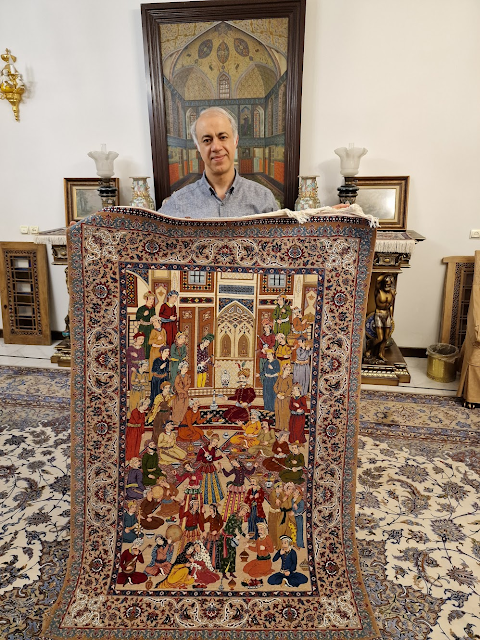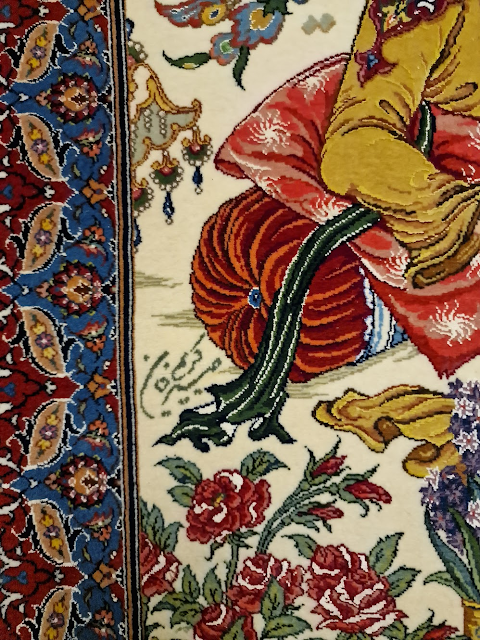The Poetic Journey of Grandmaster Akbar Mahdiei's Rugs
( شاعرانه فرش استاد اکبر مهدی ئی)
By Professor Hamed Sanei
Aarhus University, Denmark
In late March, I had the pleasure of visiting Grandmaster Akbar Mahdiei’s workshop and sitting down with him to discuss his art. Over the past decade, I have always been impressed by the beautiful rugs produced in his workshop but never had the chance to visit the master in person. Mahdiei’s rugs are distinct in their design, featuring poetic and mythical themes. The colors are vibrant, particularly famous for their unique dying of silk in a natural gold hue using the reseda plant.
Master Mahdiei received me in his beautiful gallery with his characteristic warmth and hospitality, known in Isfahan. He was accompanied by his two sons, who assist him with production and sales. What was intended to be a brief meeting, often concluding after viewing a couple of rugs, extended to 3 to 4 hours. Time seemed to slip away as I marveled at tens of spectacular masterpieces. I refrained from asking to take pictures, as some of the rugs were from his personal collection. Master Mahdiei graciously opened his treasure trove to show me these beautiful pieces, and I didn't want to overstep boundaries.
Grandmaster Mahdiei is among the rare breed of masters from the golden age of twentieth-century Isfahan, which flourished from Isfahan’s legendary Arts College led by the late Grandmaster Isa Bahadori. This college produced some of the greatest artists of the Isfahan style, including Javad Rostam Shirazi, Hooshang Jazizadeh, Mahmoud Farshchian, Jafargholi Dadkhah, and Akbar Mahdiei.
Grandmaster Akbar Mahdiei comes from a unique artistic background, having mastered Persian literature and poetry, Persian miniature drawing/painting, carpet designing, dyeing, and rug weaving. In fact, I cannot think of any artist in Isfahan who has mastered all these arts to such a high level. Each rug made by Grandmaster Mahdiei is, in fact, his poetic and philosophical expression manifested knot by knot in these stunning pieces. Besides the incredible artistic aspect of his rugs, these masterpieces are flawlessly executed and exhibit spectacular geometric and engineering perfection. His rugs bear a unique signature, sealed with stamped lead, and also feature a serial number and multiple hidden signatures in several places, making them nearly impossible to counterfeit. Additionally, the rugs come with a certificate of authenticity for those seeking further peace of mind with their purchase.
Mahdiei’s rugs stand out from miles away with their distinct vibrant colors and designs, blending realism with classic Safavid and Qajar motifs and miniature styles. He elevates realism to a whole new level, with a unique obsession that involves dissecting flowers or plants at home to understand their exact internal anatomy before drawing and painting them. This meticulous devotion to his art makes his masterpieces among the most expensive and sought-after woven pieces in the world.
I'm sharing a limited number of pictures from my visit that I managed to capture. Additionally, Mr. Amir Mahdii provided some pictures, which I've included. However, I strongly encourage you to experience the rugs firsthand by visiting their gallery at the Hotel Shah Abbas (Abbasi) in Isfahan. These rugs don't translate well through photography; their true beauty can only be appreciated up close. The intricacies of their mesmerizing shades, lustrous effects, and play of light are beyond what photography can convey.



















































































